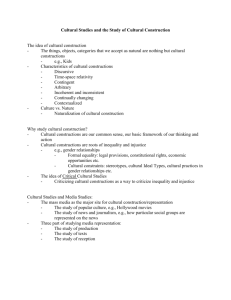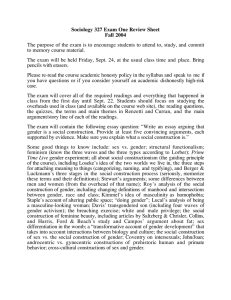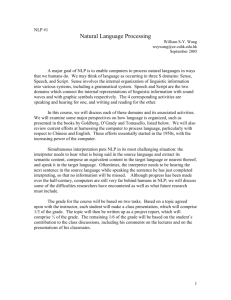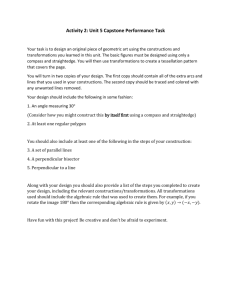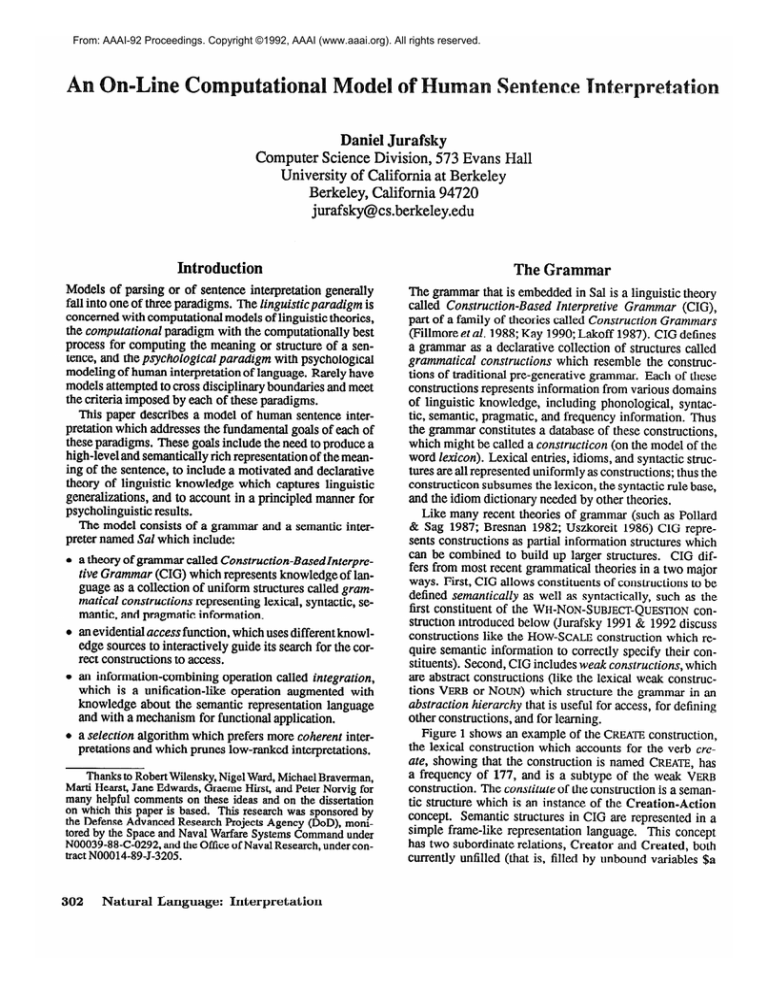
From: AAAI-92 Proceedings. Copyright ©1992, AAAI (www.aaai.org). All rights reserved.
Daniel Jurafsky
Computer Science Division, 573 Evans Hall
University of California at Berkeley
Berkeley, California 94720
jurafsky@cs.berkeley.edu
Introduction
The Grammar
Models of parsing or of sentence interpretation generally
fall into one of three paradigms. The Zinguisticparadigm is
concerned with computational models of linguistic theories,
the computational paradigm with the computationally best
process for computing the meaning or structure of a sentence, and the psychological paradigm with psychological
modeling of human interpretation of language. Rarely have
models attempted to cross disciplinary boundaries and meet
the criteria imposed by each of these paradigms.
This paper describes a model of human sentence interpretation which addresses the fundamental goals of each of
these paradigms. These goals include the need to produce a
high-level and semantically rich representation of the meaning of the sentence, to include a motivated and declarative
theory of linguistic knowledge which captures linguistic
generalizations, and to account in a principled manner for
psycholinguistic results.
The model consists of a grammar and a semantic interpreter named Sal which include:
The grammar that is embedded in Sal is a linguistic theory
a theory of grammar called Construction-Based Interpretive Grammar (CIG) which represents knowledge of language as a collection of uniform structures called grammatical constructions representing lexical, syntactic, se-
mantic, and pragmatic information.
an evidential access function, which uses different knowledge sources to interactively guide its search for the correct constructions to access.
an information-combining operation called integration,
which is a unification-like operation augmented with
knowledge about the semantic representation language
and with a mechanism for functional application.
a selection algorithm which prefers more coherent interpretations and which prunes low-ranked interpretations.
Thanks to Robert Wilensky, Nigel Ward, Michael Braverman,
Marti Hearst, Jane Edwards, Graeme Hirst, and Peter Norvig for
many helpful comments on these ideas and on the dissertation
on which this paper is based. This research was sponsored by
the Defense Advanced Research Projects Agency (DOD), monitored by the Space and Naval Warfare Systems Command under
N00039-88-C-0292, and the Office of Naval Research, under contract N00014-89-J-3205.
302
Natural
Language:
Interpretation
called Construction-Based Interpretive Grammar (GIG),
part of a family of theories called Construction Grammars
(Fillmore et al. 1988; Kay 1990; Lakoff 1987). CIG defines
a grammar as a declarative collection of structures called
grammatical constructions which resemble the construc-
tions of traditional pre-generative grammar. Each of these
constructions represents information from various domains
of linguistic knowledge, including phonological, syntactic, semantic, pragmatic, and frequency information. Thus
the grammar constitutes a database of these constructions,
which might be called a constructicon (on the model of the
word lexicon). Lexical entries, idioms, and syntactic structures are all represented uniformly as constructions; thus the
constructicon subsumes the lexicon, the syntactic rule base,
and the idiom dictionary needed by other theories.
Like many recent theories of grammar (such as Pollard
& Sag 1987; Bresnan 1982; Uszkoreit 1986) CIG represents constructions as partial information structures which
can be combined to build up larger structures. CIG differs from most recent grammatical theories in a two major
ways. First, CIG allows constituents of constructions to be
defined semantically as well as syntactically, such as the
first constituent of the WH-NON-SUBJECT-QUESTION construction introduced below (Jurafsky 1991 & 1992 discuss
constructions like the HOW-SCALEconstruction which require semantic information to correctly specify their constituents). Second, CIG includes weak constructions, which
are abstract constructions (like the lexical weak constructions VERB or NOUN) which structure the grammar in an
abstraction hierarchy that is useful for access, for defining
other constructions, and for learning.
Figure 1 shows an example of the CREATEconstruction,
the lexical construction which accounts for the verb create, showing that the construction is named CREATE, has
a frequency of 177, and is a subtype of the weak VERB
construction. The constitute of the construction is a semantic structure which is an instance of the Creation-Action
concept. Semantic structures in CIG are represented in a
simple frame-like representation language. This concept
has two subordinate relations, Creator and Created, both
currently unfilled (that is, filled by unbound variables $a
and $b). This construction has only one constituent, which
includes phonological (or graphemic) conditions specifying
the form “create”. The frequency numbers which appear in
constructions are taken as number of occurrences per million in the Brown Corpus, computed from Francis & KuEera
(1982) and Elleg&d (1978); although these works assume
different models of syntax than CIG, it was usually possible
to translate the numbers appropriately.
(a Question $q
(Queried $var)
(a
weak construction
a~--tiVerb
abstractionlink
construction frequency
----A
i
constructionnarnaW&r&&
constituteJ
177)
J
a Creation-Action $c
(creator $a)
\k variable
(Created $b))
constituent link-4-
constituent ,*“create’‘-@
Figure 2: The Wh-Non-Subject-Question Construction
graphemicconstraints
a.@
Figure 1: The “Create” Construction
A more complex construction is the WH-NON-SUBJECT(Jurafsky 1990), which accounts for
sentences which begin with certain wh-clauses which do not
function as the subject of the sentence, such as the sentence
“How can I create disk space?“. The representation for
the construction appears in Figure 2. The constitute of the
construction instantiates the Question concept; its semantics is specified by integrating the semantics of the ‘fronted’
wh-element with the semantics of the other constituents.
(Thus by not using syntactic traces, empty categories, or
coindexing as place-holders for semantic integration, Sal is
consistent with the evidence in Figure 4 that distant fillers
are directly integrated.) Each of the construction’s four constituents are specified by other predicates. The first, “how”,
is a wh-element, as shown in Figure 2 by the Identify concept. The Identify concept characterizes all wh- constructions - it instantiates a frame in which the identity of some
element is in question, and where some background information is provided to help identify the element. The second
constituent (“can”) is an auxiliary verb, and participates together with the third constituent (the NOUN-PHRASE) in the
SUBJECT-PREDICATE
construction. The second and fourth
constituents are constrained to occur in an instance of the
VERB-PHRASEconstruction.
QUESTIONconstruction
The Interpreter
As a cognitive model, Sal is qualitatively consistent with
all of the psycholinguistic results summarized in Figure 4.
These results, and the criteria discussed in the introduction
above, constrain Sal’s architecture toward four properties; it
is on-line, parallel, interactive, and uniform. Sal is on-line
because it maintains an interpretation for the utterance at all
times, updating after each constituent of each construction.
This constituent-by-constituent method is more fine-grained
and on-line than the rule-to-rule method (Bach 1976) used
by most other models which waits for semantic integration
until the completion of an entire construction or rule. Sal
is parallel because it can maintain more than one interpretation simultaneously, although only for a limited time.
Sal is interactive because it allows syntactic, semantic, and
higher-level expectations to help in the access of linguistic
information, integrate constructions into the interpretation,
and choose among candidate interpretations. Sal is uniform
because a single interpretation mechanism accounts for the
access, integration, and selection of structures at all levels
of sentence processing. Sal’s single mechanism thus subsumes a lexical analyzer, a parser, an idiom processor, and
a semantic interpreter. Figure 3 outlines the architecture.
INPUT STRING
The access threshold
The Grammar (long-term store)
X
ACCESS POINT of X
The selection threshold
SELECTION POINT
of M (because N is
pruned)
11 K Access Buffer
working
store
Interpretation Store
Figure 3: The Architecture of Sal
Sal’s architecture consists of three components: the working store, the long-term store, and the interpretation func-
Jurafsky
303
Lexical constructions are accessed in parallel.
Idioms are accessed in parallel.
Syntactic constructions are accessed in parallel.
More frequent constructions are accessed more easily.
The access-pointof a construction is not immediate, varying with
the context and the construction.
The interpreter builds interpretations on-line.
The processor uses lexical valence and control knowledge in integration, including semantic and thematic knowledge.
The processor experiences difficulty when encountering “filled
gaps” in non-subject position, but not in subject position.
The processor integrates distant fillers directly into the predicate,
rather than mediated by an empty category.
The processor prefers filling arguments to adjuncts
The processor prefer to fill expected constituents
Lexical, syntactic, and semantic knowledge are all used in computing preferences
Swinney (1979), Tanenhaus et al. (1979)
Cacciari & Tabossi (1988)
Kurtzman (1985). Gorrell(1987) and (1989)
“Qler (1984), Zwitserlood (1989). Simpson & Burgess (1985)
Swinney & Cutler (1979). Cacciari & Tabossi (1988)
Marslen-Wilson et al. (1988). Potter & Faulconer (1979). MarslenWilson (1975)
Shapiro et al. (1987), Clifton et al. (1984), Boland et al. (1990),
Tanenhaus et al. (1989)
Crain & Fodor (1985), Tanenhaus et al. (1985), Stowe (1986),
Garnsey et al. (1989), Kurtzman et al. (1991)
Pickering & Barry (1991), Boland & Tanenhaus (1991)
Ford et al. (1982)
Crain & Steedman (1985)
Taraban & McClelland (1988), Stowe (1989), Trueswell & Tanenhaus (1991), Zwitserlood (1989)
Figure 4: Sal Models Psycholinguistic Data
tion. The working store holds constructions in parallel as
they are accessed, and partial interpretations in parallel as
they are being built up. The long-term store holds the linguistic knowledge of the interpreter (i.e., the grammar). The
interpretation function includes functions of access, interpretation, and selection. The first of Sal’s sub-functions is
the access function.
Access Function: Access a construction whenever the
evidence for it passes the access threshold cy.
The access function amasses evidence for constructions that
might be used in an interpretation by assigning values to
each piece of evidence, including syntactic, semantic, and
frequency evidence, amassed from both bottom-up and topdown sources. When the evidence for a construction (i.e.,
the number of access points) has passed the access threshold a, the interpreter copies the construction into the access
buffer, which is part of the working store; this point in time
is the access point. The access buffer can hold more than
one construction in parallel - Figure 4 summarizes evidence for parallelism, variable access-point, and sensitivity
to frequency in access. This access threshold is a constant
value; the access point, however, will vary across different
constructions and contexts. This evidential access mechanism is a more general and knowledge-based approach to
the access of linguistic knowledge than previous models,
which have generally relied on a single kind of information
to access rules. This might be bottom-up information, as in
shift-reduce parsers, or top-down information, as in many
Prolog parsers, solely syntactic information, as in the above
as well as left-corner parsers, or solely semantic or Zexical information, as in conceptual analyzers like Riesbeck
& Schank (1978). The access algorithm presented here can
use any of these kinds of information, as well as frequency
information, to suggest grammatical constructions; for example top-down knowledge of a verb’s semantic argument
structure may suggest possible verb-phrase constructions
to access, while bottom-up semantic information about a
word’s meaning may suggest the access of constructions
304
Natural
Language:
Interpretation
which might begin with words of that semantic class.
Integration Function: An interpretation is built up for
each construction, as each of its constituents are processed, by integrating the partial information provided
by each constituent.
The integrationfunction incrementally combines the meaning of a construction and its various constituents into an
interpretation for the construction. The operation used to
combine structures is also called integration, designed as an
extension of the unification operation. While unification has
been used very successfully in building syntactic structure,
extending the operation to building more complex semantic
structures requires three major augmentations (see Jurafsky
(199 1) for some traces and 1992 for further details):
@ The integration operation is defined over the frame-like
representation language which is used to describe constructions. This allows the interpreter to use the same
semantic language to specify constructions as it uses to
build final interpretations, without requiring translation
from feature structures to semantics. The integration
operation can also use information about the representation language to decide if structures should integrate; for
example if the representation language specifies that construction A abstracts over construction B, the operation
will integrate them successfully.
o The integration operation distinguishes constraints on
constituents or on valence arguments fromfiZZers of constituents or valence arguments
o The integration operation is augmented by a slash operator, which allows it to join semantic structures by embedding one inside another. This is accomplished by
finding a semantic gap inside one structure (the matrix),
and binding this gap to the other structure (theJiZZer).This
operation is similar to the functional-application operation and the lambda-calculus used by other models of
semantic interpretation such as Moore (1989).
The selection function chooses an interpretation from the
set of candidate interpretations in the interpretation store.
The function chooses the interpretation which is the msst
coherent with grammatical expectations:
Selection Choice Principle: Prefer the interpretation
whose most recently integrated element wm tie most
coherent with the interpretation and its lexica.&syntactic, semantic, and probabilistic expectations.
Sal emphasizes the use of local coherence, that is, coherence with grammaticalized expectations such as valence,
constituent, or frequency expectations. Interpretations are
ranked according to the coherence ranking below:
anking (in order of preference):
(3) Integrations which fill a very strong expectation such
as one for an exact construction, or for a construction
which is extremely frequent.
(I) Integrations which fill a strong expectation such as a
valence expectation or a constituent expectation.
(I) Integrations which fill a weak expectation, SW& as
for an optional adjunct or include feature matching rather
than feature imposing.
(I) Integrations which fill no expectations, but which are
still successfully integrated into the interpretation.
Psycholinguistic evidence for preferring more coherent interpretations is summarized in Figure 4; that grammatical
expectations are useful in interpretation is not surprising.
More surprising perhaps is that these grammatical expectations can override globally more plausible interpretations
(Norvig 1988). In the following well-known garden-path
examples the reader initially arrives at an interpretation
which is semantically anomalous due to grammatical expectations:
e
e
o
e
The
The
The
The
landlord painted
horse raced past
complex houses
grappling hooks
all the walls with cracks.
the barn fell.
married and single students.
on to the enemy ship.
Although the current implementation of Sal’s grammar is
not large enough to parse these sentence, the selection algorithm does account for each of them. In each case, they
occur because the more plausible interpretation is pruned
too early, because some alternative interpretation was more
coherent. In the first sentence, the verb ‘paint’ has a valence
expectation for an instrument, in the second the main verb
sense of ‘raced’ is better integrated than the reduced relative, in the third the nominal sense of ‘houses’ is 10 times as
frequent as the verbal sense, and in the last the construction
‘grappling hooks’ has a constituent expectation for the word
‘hooks’.
Sal’s Selection Timing Principle is an extension of Gibson’s (199 1) pruning algorithm:
Selection Timing Principle: Prune interpretations
whenever the difference between their ranking and the
ranking of the most-favored interpretation is greater
than the selection threshold cr.
Interpretations are ranked according to the number of points
they are assigned by the coherence ranking above, and an
interpretation is pruned whenever it becomes much worse
st-favored interpretati
reshold, 0, at which in
the interpretation
tations are pruned,
The fact that Sal prunes less-favored interpretations online proves useful in solving some well-known complexity
problems for parsing. Many researchers have noted that
the problem of computing syntactic structure for a sentence
can be quite complex. Church & Patil(l982) showed, for
example, that the number of ambiguous phrase-structure
trees for a sentence with multiple preposition-phrases was
proportional to the Catalan numbers, while Barton et al.
(1987) showed that the parsing problem for a grammar with
agreement and lexical ambiguity is NP-complete. It might
seem that the problems of computing interpretations would
be even more complex, as the interpreter must produce a
semantic structure as well as a syntactic one.’
However, it is the need to represent ambiguities for indefinite lengths of time in parsing that causes complexity.
Sal builds interpretations on-line, and hence ambiguities are
resolved quickly, either because o
tic constraints or by the Selection
prunes less-favored interpretations on-line. Thus placing
cognitive constraints on Sal actually simplifies the processing enough to avoid complexity problems.2
elate
esearc
While there have been many models of natural language interpretation, most have been limited their scope to a single
paradigm. For example many processing models which are
associated with linguistic theories, such as Ford et al. (1982)
(LFG), lvIarcus (1980) (EST), or Fong (1991) (GB), are
solely parsing models, including no semantic knowledge.
Alternatively, some models such as Riesbeck & Schank
(1978), DeJong (1982) and others of the Yale school, emphasize semantic knowledge but exclude syntactic knowledge. Some models, such as Lytinen (1986), which do
include both syntactic and semantic knowledge, don’t address psychological criteria. Models from the psycholinguistic community often address only small domains like
lexical access.
There are some models of interpretation which attempt to
address all three paradigms. Hirst’s (1986) model included a
Marcus-like parser, a lexical disambiguation system consistent with psychological results, a semantic interpreter, and
a mechanism for resolving structural ambiguities. Hirst’s
model influenced the design of Sal; Sal differs in consist“The most common way of reducing complexity, the use of
dynamic programming techniques (e.g., well-formed substring table of Kuno (1965). the chart pursing algorithm of Kay (1973),
and the Eartey algorithm of Earley (1970)), may not generalize
from parsing to interpretation, since the internal structure of a
given substructure may be needed by the interpreter, and may
involve binding variables differently in the context of different
interpretations.
21n fact, augmenting Sal by the simple assumption that the interpreter’s working store is limited in the number of total structures
it can maintain, as suggested by Gibson (1991). would ensure that
the total amount of ambiguity the interpreter can maintain will
calwcrysbe limited by a small constant.
Jurafsky
305
ing of a single unified mechanism rather than four separate
modules, and emphasizing the use of semantic knowledge
directly in the CIG grammar, thus accounting for longdistance dependencies and other phenomena in semantic
rather than syntactic ways.
Cardie Jz Lehnert’s (1991) interpreter resembles Sal in
attempting to model psychological results, particularly in
the use of semantic constraints to process wh-clauses. Their
system differs from Sal in its focus, emphasizing robustness
rather than linguistic criteria. For example, the interpreter
doesn’t represent larger grammatical constructions, only including local intraclausal linguistic information. Also, because their model only allows linguistic structures to be
accessed bottom-up by lexical input, it is unable to account
for psycholinguistic results on access in Figure 4.
Implementation Comments
Sal has been implemented in Common Lisp with a small
CIG test grammar of about 50 constructions. This section
presents a trace of the interpretation of the sentence “How
can I create disk space?“.
In the first part of the trace the input word “how” supplies sufficient evidence for two constructions, MEANSHow and HOW-SCALEto be accessed. These constructions
then supply evidence for the WH-NON-SUBJECT-QUESTION
construction, and these are integrated together. At the end of
this stage, the interpretation store contains two WH-NONSUBJECT-QUESTIONinterpretations, one with the MEANSHOW construction and one with the HOW-SCALEconstruction.
In this second part of the trace, the input “can” provides
evidence for the three lexical constructions CAN-~,CAN-~,
and CAN-~, as well as some larger constructions. After
integration, the interpretation store contains a large number of possible interpretations, most of which are ruled out
because they failed to integrate successfully, leaving only
one. This successful interpretation includes the MEANSHOW construction and the auxiliary sense of “can”.
Next the word 7” is input and integrated into the interpretation. Note that although there is some top-down
evidence for the verb-phrase construction (because the
WH-NON-SUBJECT-QUESTIONconstruction expects a verbphrase next), it is not accessed, because it is an abstract weak
construction, and there is insufficient evidence for any of
the more concrete strong verb-phrase constructions. Next
the word “create” is input and integrated into the interpretation, along with an appropriate type of verb-phrase. Again,
the top-down evidence for the abstract NOUN-PHRASE construction is insufficient to access it. Next the word “disk”
is input, which provides evidence for the lexical construction DISK, as well as the noun-compound DISK-SPACE,and
the DOUBLENOUN construction, which handles compound
nouns.
Finally, the word “space” accesses the lexical construction SPACE. The selection algorithm must now choose between two interpretations, one with the DISK-SPACE construction, and one with the DOUBLENOUN construction in
which the nouns are respectively “disk” and “space”. Be306
Natural
Language:
Interpretation
<cl>
(parse
' (how can
i create
disk
space))
*** ACCESS ***
Input word: how
Bottom-up
Evidence
for constructions
(means-how
howscale)
Constructions
(means-how howscale)
are accessed
Bottom-up
Access of (whnonsubjectquestion),
integrated
directly
into Access Buffer
Top-down Evidence
for constructions
(aux)
Access of constructions
nil
*** INTEGRATION
***
After integration,
Store contains:
((whnonsubjectquestion
whnonsubjectquestion
whnonsubjectquestion))
*** SELECTION
***
After removing
failed
(whnonsubjectquestion
integrations
Store contains
whnonsubjectquestion)
*** ACCESS ***
Input word: can
Bottom-up
Evidence
for constructions
(can-l
can-2 can-3 doublenoun
bare-mono-trans-vp)
Top-down Evidence
for constructions
nil
Access of constructions
nil
*** INTEGRATION
***
After integration,
Store contains:
((whnonsubjectquestion
whnonsubjectquestion
whnonsubjectquestion
whnonsubjectquestion
whnonsubjectquestion
whnonsubjectquestion
whnonsubjectquestion
whnonsubjectquestion
whnonsubjectquestion
whnonsubjectquestion
whnonsubjectquestion
whnonsubjectquestion))
*** SELECTION
***
After removing
failed
(whnonsubjectquestion)
integrations
*** ACCESS ***
Input word: i
Bottom-up
Evidence
for constructions
Top-down Evidence
for constructions
Access of constructions
nil
Store
contains
(i)
(verb-phrase)
*** INTEGRATION
***
After integration,
Store contains:
((whnonsubjectquestion
whnonsubjectquestion))
*** SELECTION
***
After removing
failed
(whnonsubjectquestion)
integrations
*** ACCESS ***
Input word: create
Bottom-up
Evidence
for constructions
bare-mono-trans-vp)
Top-down Evidence
for constructions
Access of constructions
nil
Store
contains
(create
(noun-phrase)
*** INTEGRATION
***
After integration,
Store contains:
((whnonsubjectquestion
whnonsubjectquestion
whnonsubjectquestion))
*** SELECTION
***
After removing
failed
(whnonsubjectquestion)
integrations
Store
contains
cause the DISK-SPACE construction has a strong expectation
for the word “space”, this first interpretation is selected.
*** ACCESS ***
Input word: disk
Bottom-up
Evidence
for constructions
diskspace
doublenoun)
Top-down Evidence
for constructions
Access of constructions
nil
(disk
(noun)
*** INTEGRATION
***
After integration,
Store contains:
((whnonsubjectquestion
whnonsubjectquest
whnonsubjectquestion
whnonsubjectquesti
*** SELECTION
***
After removing
failed
(whnonsubjectquestion
ion
on) 1
integrations
Store contains
whnonsubjectquestion)
*** ACCESS ***
Input word: space
Bottom-up
Evidence
for constructions
doublenoun)
Top-down Evidence
for constructions
Access of constructions
nil
(space
nil
*** INTEGRATION
***
After integration,
Store contains:
((whnonsubjectquestion
whnonsubjectquestion
whnonsubjectquestion
whnonsubjectquestion
whnonsubjectquestion
whnonsubjectquestion))
*** SELECTION
***
After removing
failed integrations
Store contains
(whnonsubjectquestion
whnonsubjectquestion)
'whnonsubjectquestion'
Pruning construction
because difference
from construction
(1 points),
'whnonsubjectquestion'
(3 points) exceeds
selection
threshold
Input Exhausted.
Result is:
(a question
$q
(queried $p*)
(background
(a means-for
Snewvar285
(means Sp*)
(goal
(a ability-state
Sas
(actor (a speechsituation-speaker))
(action
(a forcedynamicaction
Snewvar291
(action
(a creation-action
(created
(a disk-freespace))
(creator
(a speechsitn-speaker
Summary
Sal and CIG arose from an attempt to build a model which
jointly incorporated the insights of artificial intelligence and
natural language processing systems, of psycholinguistic
models of processing, and of linguistic models of grammatical representation. The interdisciplinary nature of the
work results in a number of advantages. First, combining
syntactic, semantic, lexical and idiomatic knowledge in a
single linguistic knowledge structure, the grammatical con-
struction, obviates the need for a separate lexical analyzer,
parser, and semantic interpreter, and allows access, integration, and selection to be sensitive to a rich framework of
linguistic evidence. Second, by filling the roles of a parser,
a semantic interpreter, a linguistic model, and a cognitive
model, Sal can use linguistic functionality such as capturing
generalizations to aid construction access, and cognitive requirements such as modeling human memory limitations to
reduce processing complexity.
eferences
BACH, EMMON. 1976. An extension
of classical transformational
grammar. In Problems of Linguistic Metatheory (Proceedings of
the 1976 Conference). Michigan State University.
BARTON, JR, 6. EDWARD, ROBERT C. BERWICK, & ERIC SVEN
RIsTm. 1987. Computational complexity and natural language.
Cambridge, MA: MIT Press.
BOLAND, JULIE E. & MICHAEL K. TANENHAUS. 1991. The role of
lexical representations in sentence processing. In Understanding
word and sentence, ed. by G. B. Simpson, 33 l-366. Elsevier.
BOLAND, JULIE E., MICHAEL K. TANENHAus, t!k SUSAN M. GAIXNSEY. 1990. Evidence for the immediate use of verb control
Journal of Memory and
information in sentence processing.
Language, 29~413-432.
BRESNAN, JOAN (ed.). 1982. The mental representation ofgrammatical relations. Cambridge, MA: MIT Press.
CACCWRI, CRISTINA & PATRIZA TABOSSI. 1988. The comprehension of idioms. Journal of Memory and Language, 27:668-683.
CARDIE, CLAIRE 8c WENDY LEHNERT. 1991. A cognitively plausible approach to understanding complex syntax. In Proceedings
of the Ninth AAAI, 117-124. Morgan Kaufmann.
CHURCH, KENNETH& &WESH PATIL.1982. Coping with syntactic
ambiguity. American Journal of Computational Linguistics, 8(34): 139-149.
ON,
JR, CHARLES, LYN FIuzlER, & CyruHIA co-.
1984. Lexical expectations in sentence comprehension.
Journal of Verbal Learning and Verbal Behavior, 23~696-708.
GRAIN, STEPHEN & JANET DEAN FODOR. 1985. How can grammars help parsers? In Natural languageparsing, ed. by David R.
Dowty, Lauri Kartunnen, & Arnold Zwicky, 94-128. Cambridge:
Cambridge University Press.
GRAIN, STEPHEN& MA.RK STEEDMAN. 1985. On not being led up
the garden path: the use of context by the psychological syntax
processor. In Natural language parsing, ed. by David R. Dowty,
Lauri Kartunnen, & Arnold Zwicky, 320-358. Cambridge: Cambridge University Press.
DEJONG, GERALD. 1982. An overview of the FRUMP system.
In Strategies for natural language processing, ed. by Wendy G.
Lehnert & Martin H. Ringle, 149-176. NJ: Lawrence Erlbaum.
EARLEY, JAY. 1970. An efficient context-free parsing algorithm.
Communications of the ACM, 6(8):45 1-455.
ELLEG&,
ALVAR. 1978. The syntactic structure of English
texts: A computer-based study offour kinds of text in the Brown
University Corpus. Number 43 in Gothenburg Studies in English.
Goteborg: Acta Universitatis Gothoburgensis.
FLLLMORE,CHARLES J., PAUL KAY, & M. C. O’CONNOR. 1988.
Regularity and idiomatic@ in grammatical constructions: The
case of let alone. Language, 64(3):501-538.
FONG, SANDIWAY. 1991. The computational implementation
of principle-based parsers. In Principle-based parsing, ed. by
Jurafsky
307
Robert C. Berwick, Steven P. Abney, & Carol Tenny, 65-82.
Dordrecht: Kluwer.
FORD, MARILYN, JOAN BRESNAN, & RONALD M. KAPLAN. 1982.
A competence-based
theory of syntactic closure. In The mental
representation of grammatical relations, ed. by Joan Bresnan.
Cambridge, MA: MIT Press.
FRANCIS,W. NELSON & HENRY K&ERA. 1982. Frequency analysis of English usage. Boston: Houghton Mifflin.
GARNSEY, SUSAN M., MICHAJX K. TANENHAus, & ROBERT M.
CHAPMAN. 1989. Evoked potentials and the study of sentence
comprehension. Journal of Psycholinguistic Research, 18( 1):5 l60.
GIBSON, EDWARD, 1991. A computational theory ofhuman linguistic processing: Memory limitations and processing breakdown.
Pittsburgh, PA: Carnegie Mellon University dissertation.
GORRELL,PAUL G., 1987. Studies of human syntacticprocessing:
Ranked-parallel versus serial models. Connecticut: University
of Connecticut dissertation.
GORRELL, PAUL G. 1989. Establishing the loci of serial and parallel effects in syntactic processing. Journal of Psycholinguistic
Research, 18(1):61-73.
HIRST,GRAEME. 1986. Semantic interpretation and the resolution
of ambiguity. Cambridge: Cambridge University Press.
JURAFSKY,DANIEL. 1990. Representing and integrating linguistic
knowledge. In Proceedings of 13th Coling, 199-204, Helsinki.
J-SKY,
DANIEL. 1991. An on-line model of human sentence
interpretation. In Proceedings of the 13th Annual Conference of
the Cognitive Science Society, 449-454, Chicago.
JURAFSKY,DANIEL, 1992. An on-line computational model of human sentence interpretation: A theory of the representation and
use of linguistic knowledge. Berkeley, CA: University of California dissertation. Computer Science Division Report #92/676.
KAY, MARTIN. 1973. The MIND system. In Natural language
processing, ed. by Randall Rustin, 155-188. New York: Algorithmics Press.
KAY, PAUL. 1990. Even. Linguistics and Philosophy, 13:59-216.
KUNO, SUSUMU. 1965. The predictive analyzer and a path elimination technique. Communications of the ACM, 8(7):453-462.
KIJR‘IZMAN, HOWARD S., 1985. Studies in syntactic ambiguity
resolution. Cambridge, MA: MIT dissertation.
KURTZMAN, HOWARD S., L~REN F. CRAWFORD, & CAYLEE
NYCHIS-FLORENCE. 1991. Locating wh- traces. In Principlebased parsing, ed. by Robert C. Berwick, Steven P. Abney, &
Carol Tenny, 347-382. Dordrecht: Kluwer.
LAKOF~F,GEORGE. 1987. Women, Jire, and dangerous things.
Chicago: University of Chicago Press.
LYTINEN,STEVEN L. 1986. Dynamically combining syntax and
semantics in natural language processing. In Proceedings of the
Fi;frhAAAI, volume 1,574-578. Morgan Kaufmann.
MARCUS, MITCHELL P. 1980. A theory of syntactic recognition
for natural language. Cambridge, MA: MIT Press.
MARSLEN-WILSON, WILLIAM. 1975. Sentence perception as an
interactive parallel process. Science, 189:226-228.
MARSLEN-WILSON, WILLIAM, COLIN M. BROWN, & LORRAINE KOMISARJEVSKYTYLER. 1988. Lexical representations
in spoken language comprehension.
Language and Cognitive
Processes, 3(1):1-16.
MOORE, ROBERT C. 1989. Unification-based
semantic interpretation. In Proceedings of the 27th Annual Conference of the
Association for Computational Linguistics, 33-41, Vancouver,
Canada.
308
Natural
Language:
Interpretation
NORVIG, PETER. 1988. Interpretation
under ambiguity. In Proceedings of the I4th Annual Meeting of the Berkeley Linguistics
Society, 188-201, Berkeley, CA.
~CKERING, MARTIN & GUY BARRY. 1991. Sentence processing
without empty categories. Language and Cognitive Processes,
6(3):229-259.
POLLARD, CARL & IVAN A. SAG. 1987. Information-based syntax
and semantics: Volume 1: Fundamentals. Chicago: University
of Chicago Press.
POITER, MARY C. Br BARBARA A. FAULCONER. 1979. Understanding noun phrases. Journal of Verbal Learning and Verbal
Behavior, 18:509-521.
-BECK,
CHRISTOPHERK. & ROGERC. SCHANK. 1978. Comprehension by computer: Expectation-based analysis of sentences in
context. PnStudies in the perception of language, ed. by W. J. M.
Levelt & G. B. Flores d’Arcais, 247-293. London: Wiley.
SHAPIRO, L. P., E. ZURIF, & J. GIUMSHAW. 1987. Sentence
processing and the mental representation of verbs. Cognition,
27:219-246.
SIMPSON,GREG B. & CURT BIJRGE~S.1985. Activation and selection processes in the recognition of ambiguous words. Journal of
Experimental Psychology: Human Perception and Performance,
11(1):28-39.
STOWE?.,LAURIE A. 1986. Evidence for on-line gap location.
Language and Cognitive Processes, 1(3):227-245.
STOWE, LAURIE A. 1989. Thematic structures and sentence comprehension. In Linguistic structure in languageprocessing, ed. by
G. N. Carlson & M. K. Tanenhaus, 3 19-357. Dordrecht: Kluwer.
SWINNEY,DAVID A. 1979. Lexical accessduring sentencecomprehension: (re)consideration of context effects. Journal of Verbal
Learning and Verbal Behavior, 18~645-659.
SWLNNEY,DAVY, A. & ANNE CUTLER. 1979. The access and
processing of idiomatic expressions. Journal of Verbal Learning
and Verbal Behavior, 18~523-534.
TANENHAUS, MICHA~, K., JULIEE. BOLAND, SUSAN M. GARNSEY,
& GREG CARLSON. 1989. Lexical structures in parsing longdistance dependencies.
Journal of Psycholinguistic Research,
18( 1):37-50.
TANENHAUS, MICHAEL K., JAMES M. LEIMAN, & MARK S. SF%
DENFSERG.1979. Evidence for multiple stages in the processing
of ambiguous words in syntactic contexts. Journal of Verbal
Learning and Verbal Behavior, 18~427-440.
TANENHAUS,MICHAEL K., LAURIE A. STOWE, BcGREG CARLSON.
1985. The interaction of lexical expectation and pragmatics in
In Program of the 7th Annual
parsing filler-gap constructions.
Conference of the Cognitive Science Society, 361-365, Irvine.
TARABAN, ROMAN h JAMES L. McC LELLAND. 1988. Constituent
attachment and thematic role assignment in sentence processing:
Influences of content-based expectations.
Journal of Memory
and Language, 27~597-632.
TRUESWELL, JOHN C. & MICHAEL K. TANENHAUS. 1991. Tense,
temporal context and syntactic ambiguity resolution. Language
and Cognitive Processes, 6(4):303-338.
TYLER, LORRAINEK. 1984. The structure of the initial cohort:
Evidence from gating. Perception & Psychophysics, 36(5):417427.
USZICOR~T, HANS. 1986. Categorial unification grammars.
In
Proceedings of 11 th Coling, Bonn. University of Bonn.
ZW~TSJZRL~OD,
PIENIE. 1989. Thelocus of the effects of sententialsemantic context in spoken-word processing. Cognition, 32:2564.

